Contemporary Accounting Theory: Regulatory Environments & Capture
VerifiedAdded on 2023/06/13
|14
|3648
|194
Report
AI Summary
This report provides a comprehensive literature review of the regulatory environments for financial reporting in India and Australia, analyzing them through the lens of regulatory capture theory. Part A compares the regulatory frameworks of India (Companies Act 2013, SEBI) and Australia (APRA, ASIC, RBA), examining their perceived problems, operational mechanisms, and progress towards IFRS adoption. Part B delves into regulatory capture theory, exploring its usefulness and identifying key characteristics that regulatory systems should possess, such as effectiveness, flexibility, consistency, accountability, and transparency, to ensure public interest is served. The conclusion summarizes the findings, assessing the regulatory frameworks of both countries based on the principles of regulatory capture theory, highlighting the importance of regulatory authorities working in the public interest rather than for specific interest groups. Desklib offers similar solved assignments and past papers for students.
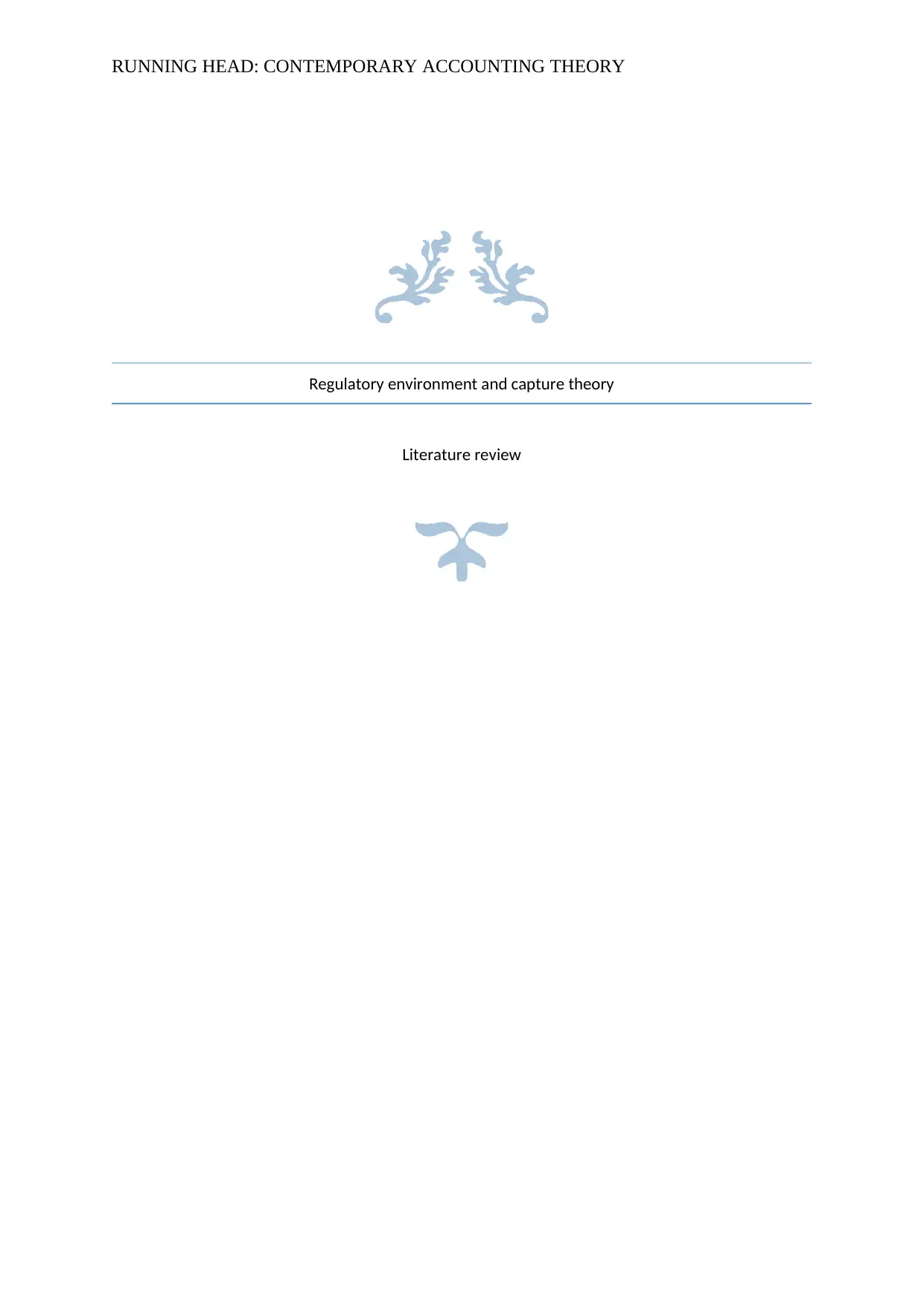
RUNNING HEAD: CONTEMPORARY ACCOUNTING THEORY
Regulatory environment and capture theory
Literature review
Regulatory environment and capture theory
Literature review
Paraphrase This Document
Need a fresh take? Get an instant paraphrase of this document with our AI Paraphraser
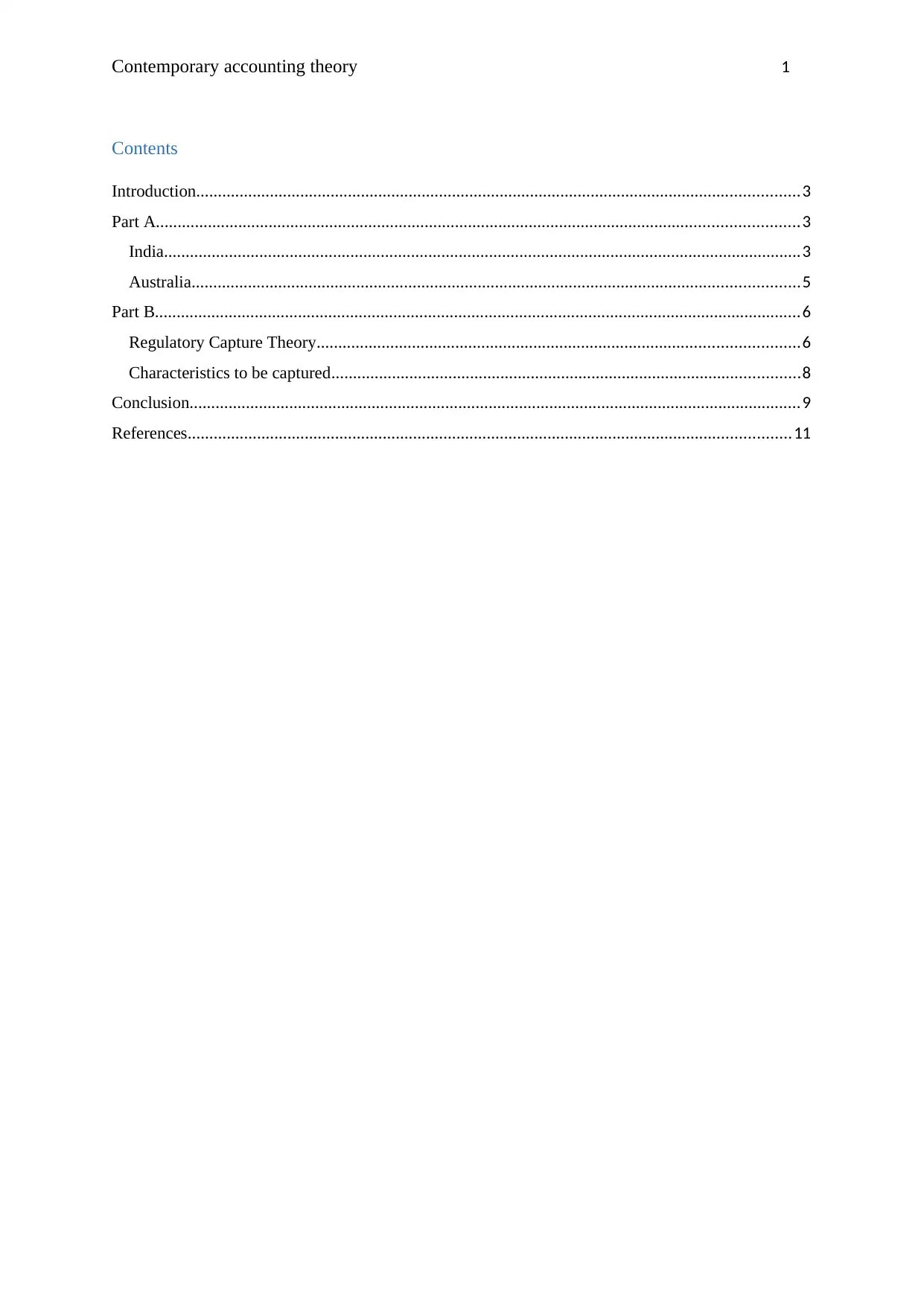
Contemporary accounting theory 1
Contents
Introduction...........................................................................................................................................3
Part A....................................................................................................................................................3
India...................................................................................................................................................3
Australia............................................................................................................................................5
Part B.....................................................................................................................................................6
Regulatory Capture Theory...............................................................................................................6
Characteristics to be captured............................................................................................................8
Conclusion.............................................................................................................................................9
References...........................................................................................................................................11
Contents
Introduction...........................................................................................................................................3
Part A....................................................................................................................................................3
India...................................................................................................................................................3
Australia............................................................................................................................................5
Part B.....................................................................................................................................................6
Regulatory Capture Theory...............................................................................................................6
Characteristics to be captured............................................................................................................8
Conclusion.............................................................................................................................................9
References...........................................................................................................................................11
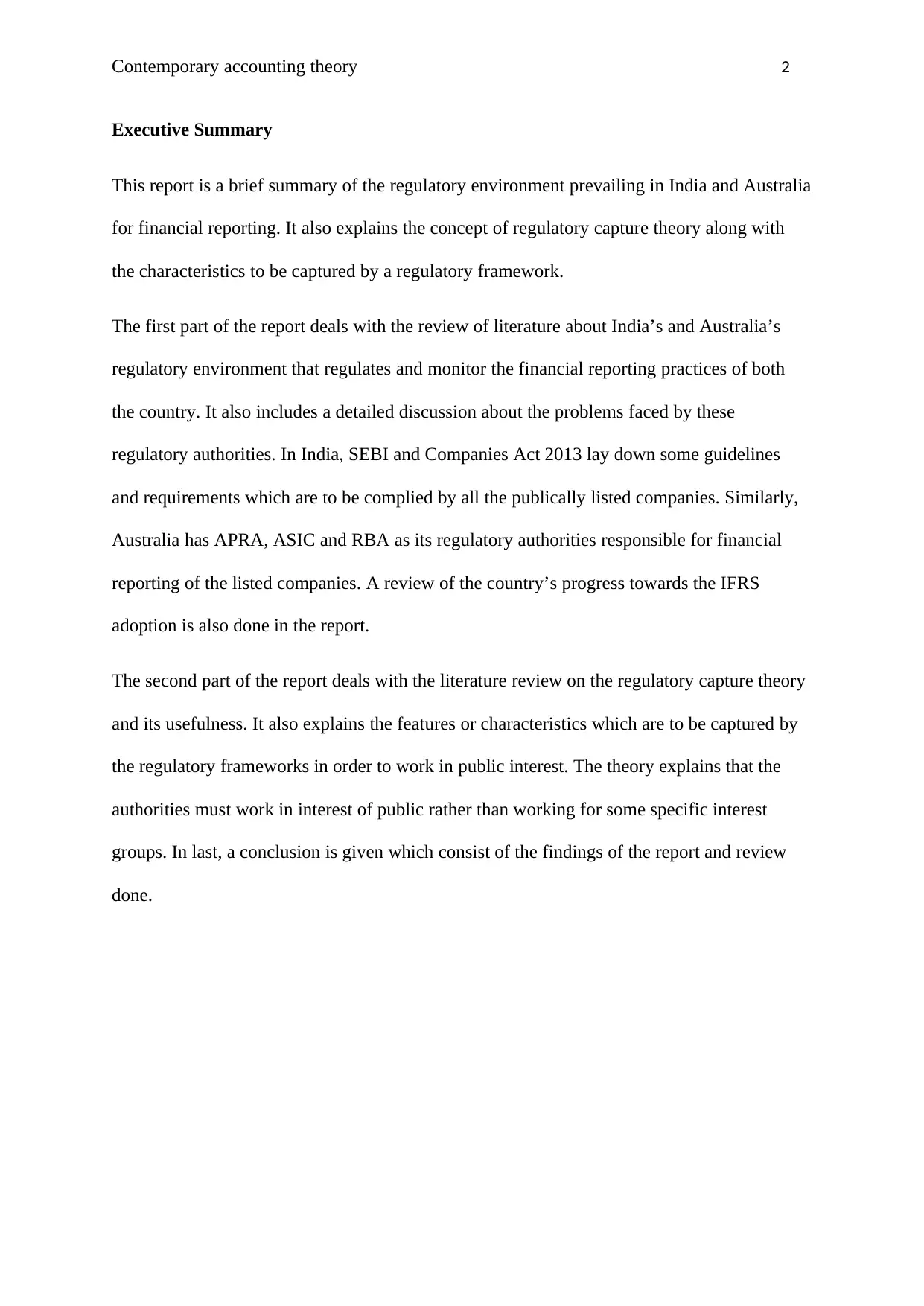
Contemporary accounting theory 2
Executive Summary
This report is a brief summary of the regulatory environment prevailing in India and Australia
for financial reporting. It also explains the concept of regulatory capture theory along with
the characteristics to be captured by a regulatory framework.
The first part of the report deals with the review of literature about India’s and Australia’s
regulatory environment that regulates and monitor the financial reporting practices of both
the country. It also includes a detailed discussion about the problems faced by these
regulatory authorities. In India, SEBI and Companies Act 2013 lay down some guidelines
and requirements which are to be complied by all the publically listed companies. Similarly,
Australia has APRA, ASIC and RBA as its regulatory authorities responsible for financial
reporting of the listed companies. A review of the country’s progress towards the IFRS
adoption is also done in the report.
The second part of the report deals with the literature review on the regulatory capture theory
and its usefulness. It also explains the features or characteristics which are to be captured by
the regulatory frameworks in order to work in public interest. The theory explains that the
authorities must work in interest of public rather than working for some specific interest
groups. In last, a conclusion is given which consist of the findings of the report and review
done.
Executive Summary
This report is a brief summary of the regulatory environment prevailing in India and Australia
for financial reporting. It also explains the concept of regulatory capture theory along with
the characteristics to be captured by a regulatory framework.
The first part of the report deals with the review of literature about India’s and Australia’s
regulatory environment that regulates and monitor the financial reporting practices of both
the country. It also includes a detailed discussion about the problems faced by these
regulatory authorities. In India, SEBI and Companies Act 2013 lay down some guidelines
and requirements which are to be complied by all the publically listed companies. Similarly,
Australia has APRA, ASIC and RBA as its regulatory authorities responsible for financial
reporting of the listed companies. A review of the country’s progress towards the IFRS
adoption is also done in the report.
The second part of the report deals with the literature review on the regulatory capture theory
and its usefulness. It also explains the features or characteristics which are to be captured by
the regulatory frameworks in order to work in public interest. The theory explains that the
authorities must work in interest of public rather than working for some specific interest
groups. In last, a conclusion is given which consist of the findings of the report and review
done.
⊘ This is a preview!⊘
Do you want full access?
Subscribe today to unlock all pages.

Trusted by 1+ million students worldwide
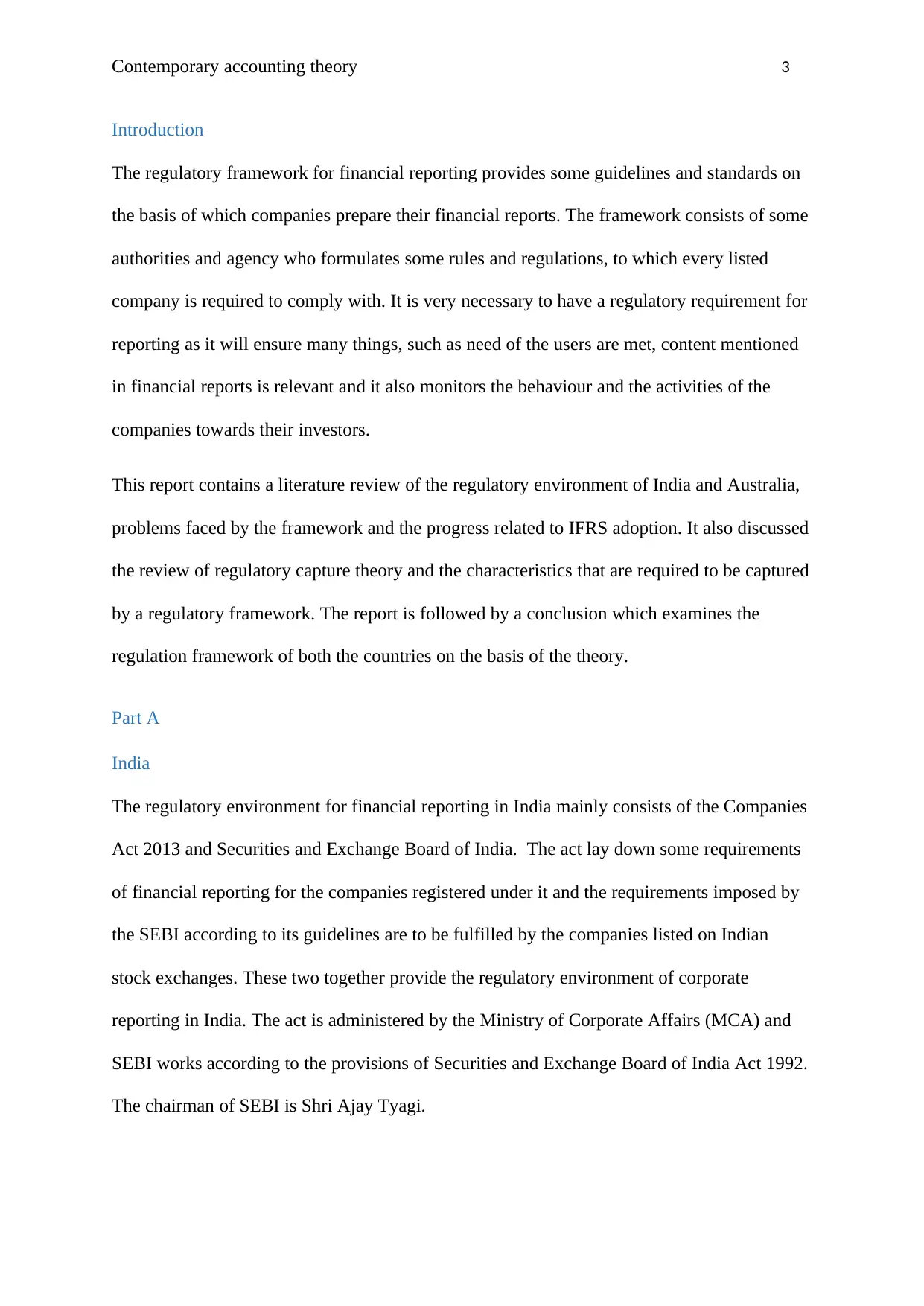
Contemporary accounting theory 3
Introduction
The regulatory framework for financial reporting provides some guidelines and standards on
the basis of which companies prepare their financial reports. The framework consists of some
authorities and agency who formulates some rules and regulations, to which every listed
company is required to comply with. It is very necessary to have a regulatory requirement for
reporting as it will ensure many things, such as need of the users are met, content mentioned
in financial reports is relevant and it also monitors the behaviour and the activities of the
companies towards their investors.
This report contains a literature review of the regulatory environment of India and Australia,
problems faced by the framework and the progress related to IFRS adoption. It also discussed
the review of regulatory capture theory and the characteristics that are required to be captured
by a regulatory framework. The report is followed by a conclusion which examines the
regulation framework of both the countries on the basis of the theory.
Part A
India
The regulatory environment for financial reporting in India mainly consists of the Companies
Act 2013 and Securities and Exchange Board of India. The act lay down some requirements
of financial reporting for the companies registered under it and the requirements imposed by
the SEBI according to its guidelines are to be fulfilled by the companies listed on Indian
stock exchanges. These two together provide the regulatory environment of corporate
reporting in India. The act is administered by the Ministry of Corporate Affairs (MCA) and
SEBI works according to the provisions of Securities and Exchange Board of India Act 1992.
The chairman of SEBI is Shri Ajay Tyagi.
Introduction
The regulatory framework for financial reporting provides some guidelines and standards on
the basis of which companies prepare their financial reports. The framework consists of some
authorities and agency who formulates some rules and regulations, to which every listed
company is required to comply with. It is very necessary to have a regulatory requirement for
reporting as it will ensure many things, such as need of the users are met, content mentioned
in financial reports is relevant and it also monitors the behaviour and the activities of the
companies towards their investors.
This report contains a literature review of the regulatory environment of India and Australia,
problems faced by the framework and the progress related to IFRS adoption. It also discussed
the review of regulatory capture theory and the characteristics that are required to be captured
by a regulatory framework. The report is followed by a conclusion which examines the
regulation framework of both the countries on the basis of the theory.
Part A
India
The regulatory environment for financial reporting in India mainly consists of the Companies
Act 2013 and Securities and Exchange Board of India. The act lay down some requirements
of financial reporting for the companies registered under it and the requirements imposed by
the SEBI according to its guidelines are to be fulfilled by the companies listed on Indian
stock exchanges. These two together provide the regulatory environment of corporate
reporting in India. The act is administered by the Ministry of Corporate Affairs (MCA) and
SEBI works according to the provisions of Securities and Exchange Board of India Act 1992.
The chairman of SEBI is Shri Ajay Tyagi.
Paraphrase This Document
Need a fresh take? Get an instant paraphrase of this document with our AI Paraphraser
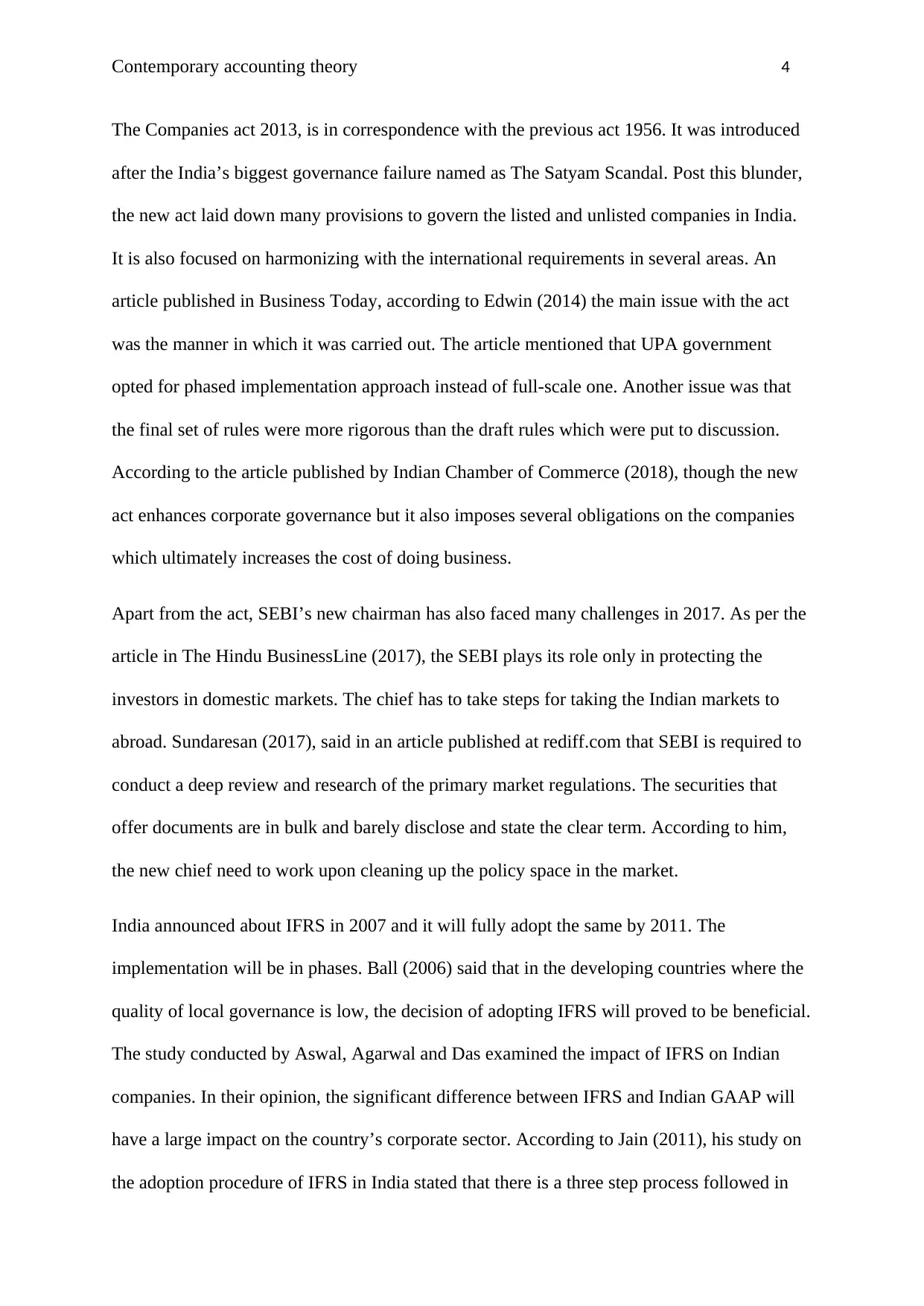
Contemporary accounting theory 4
The Companies act 2013, is in correspondence with the previous act 1956. It was introduced
after the India’s biggest governance failure named as The Satyam Scandal. Post this blunder,
the new act laid down many provisions to govern the listed and unlisted companies in India.
It is also focused on harmonizing with the international requirements in several areas. An
article published in Business Today, according to Edwin (2014) the main issue with the act
was the manner in which it was carried out. The article mentioned that UPA government
opted for phased implementation approach instead of full-scale one. Another issue was that
the final set of rules were more rigorous than the draft rules which were put to discussion.
According to the article published by Indian Chamber of Commerce (2018), though the new
act enhances corporate governance but it also imposes several obligations on the companies
which ultimately increases the cost of doing business.
Apart from the act, SEBI’s new chairman has also faced many challenges in 2017. As per the
article in The Hindu BusinessLine (2017), the SEBI plays its role only in protecting the
investors in domestic markets. The chief has to take steps for taking the Indian markets to
abroad. Sundaresan (2017), said in an article published at rediff.com that SEBI is required to
conduct a deep review and research of the primary market regulations. The securities that
offer documents are in bulk and barely disclose and state the clear term. According to him,
the new chief need to work upon cleaning up the policy space in the market.
India announced about IFRS in 2007 and it will fully adopt the same by 2011. The
implementation will be in phases. Ball (2006) said that in the developing countries where the
quality of local governance is low, the decision of adopting IFRS will proved to be beneficial.
The study conducted by Aswal, Agarwal and Das examined the impact of IFRS on Indian
companies. In their opinion, the significant difference between IFRS and Indian GAAP will
have a large impact on the country’s corporate sector. According to Jain (2011), his study on
the adoption procedure of IFRS in India stated that there is a three step process followed in
The Companies act 2013, is in correspondence with the previous act 1956. It was introduced
after the India’s biggest governance failure named as The Satyam Scandal. Post this blunder,
the new act laid down many provisions to govern the listed and unlisted companies in India.
It is also focused on harmonizing with the international requirements in several areas. An
article published in Business Today, according to Edwin (2014) the main issue with the act
was the manner in which it was carried out. The article mentioned that UPA government
opted for phased implementation approach instead of full-scale one. Another issue was that
the final set of rules were more rigorous than the draft rules which were put to discussion.
According to the article published by Indian Chamber of Commerce (2018), though the new
act enhances corporate governance but it also imposes several obligations on the companies
which ultimately increases the cost of doing business.
Apart from the act, SEBI’s new chairman has also faced many challenges in 2017. As per the
article in The Hindu BusinessLine (2017), the SEBI plays its role only in protecting the
investors in domestic markets. The chief has to take steps for taking the Indian markets to
abroad. Sundaresan (2017), said in an article published at rediff.com that SEBI is required to
conduct a deep review and research of the primary market regulations. The securities that
offer documents are in bulk and barely disclose and state the clear term. According to him,
the new chief need to work upon cleaning up the policy space in the market.
India announced about IFRS in 2007 and it will fully adopt the same by 2011. The
implementation will be in phases. Ball (2006) said that in the developing countries where the
quality of local governance is low, the decision of adopting IFRS will proved to be beneficial.
The study conducted by Aswal, Agarwal and Das examined the impact of IFRS on Indian
companies. In their opinion, the significant difference between IFRS and Indian GAAP will
have a large impact on the country’s corporate sector. According to Jain (2011), his study on
the adoption procedure of IFRS in India stated that there is a three step process followed in
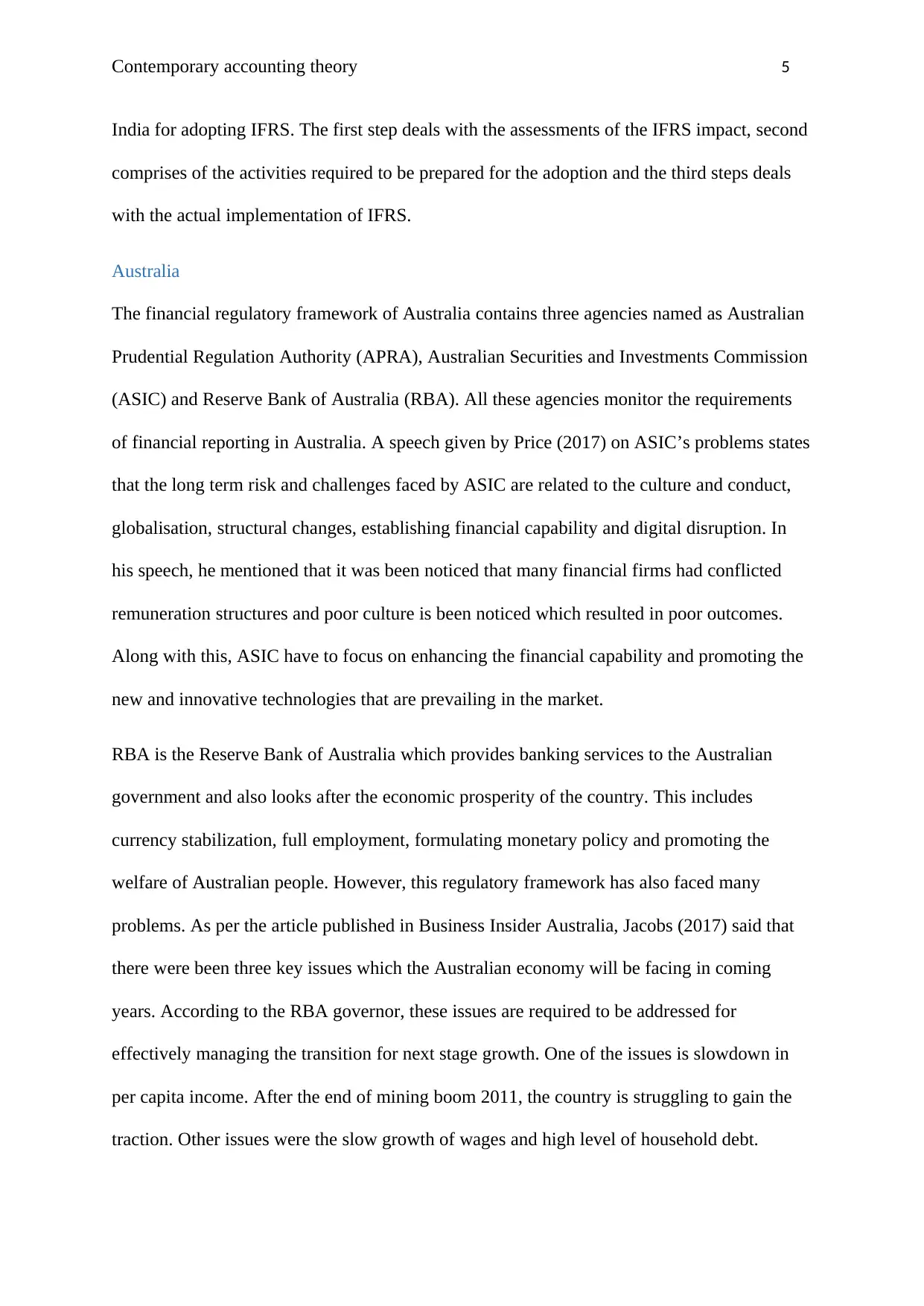
Contemporary accounting theory 5
India for adopting IFRS. The first step deals with the assessments of the IFRS impact, second
comprises of the activities required to be prepared for the adoption and the third steps deals
with the actual implementation of IFRS.
Australia
The financial regulatory framework of Australia contains three agencies named as Australian
Prudential Regulation Authority (APRA), Australian Securities and Investments Commission
(ASIC) and Reserve Bank of Australia (RBA). All these agencies monitor the requirements
of financial reporting in Australia. A speech given by Price (2017) on ASIC’s problems states
that the long term risk and challenges faced by ASIC are related to the culture and conduct,
globalisation, structural changes, establishing financial capability and digital disruption. In
his speech, he mentioned that it was been noticed that many financial firms had conflicted
remuneration structures and poor culture is been noticed which resulted in poor outcomes.
Along with this, ASIC have to focus on enhancing the financial capability and promoting the
new and innovative technologies that are prevailing in the market.
RBA is the Reserve Bank of Australia which provides banking services to the Australian
government and also looks after the economic prosperity of the country. This includes
currency stabilization, full employment, formulating monetary policy and promoting the
welfare of Australian people. However, this regulatory framework has also faced many
problems. As per the article published in Business Insider Australia, Jacobs (2017) said that
there were been three key issues which the Australian economy will be facing in coming
years. According to the RBA governor, these issues are required to be addressed for
effectively managing the transition for next stage growth. One of the issues is slowdown in
per capita income. After the end of mining boom 2011, the country is struggling to gain the
traction. Other issues were the slow growth of wages and high level of household debt.
India for adopting IFRS. The first step deals with the assessments of the IFRS impact, second
comprises of the activities required to be prepared for the adoption and the third steps deals
with the actual implementation of IFRS.
Australia
The financial regulatory framework of Australia contains three agencies named as Australian
Prudential Regulation Authority (APRA), Australian Securities and Investments Commission
(ASIC) and Reserve Bank of Australia (RBA). All these agencies monitor the requirements
of financial reporting in Australia. A speech given by Price (2017) on ASIC’s problems states
that the long term risk and challenges faced by ASIC are related to the culture and conduct,
globalisation, structural changes, establishing financial capability and digital disruption. In
his speech, he mentioned that it was been noticed that many financial firms had conflicted
remuneration structures and poor culture is been noticed which resulted in poor outcomes.
Along with this, ASIC have to focus on enhancing the financial capability and promoting the
new and innovative technologies that are prevailing in the market.
RBA is the Reserve Bank of Australia which provides banking services to the Australian
government and also looks after the economic prosperity of the country. This includes
currency stabilization, full employment, formulating monetary policy and promoting the
welfare of Australian people. However, this regulatory framework has also faced many
problems. As per the article published in Business Insider Australia, Jacobs (2017) said that
there were been three key issues which the Australian economy will be facing in coming
years. According to the RBA governor, these issues are required to be addressed for
effectively managing the transition for next stage growth. One of the issues is slowdown in
per capita income. After the end of mining boom 2011, the country is struggling to gain the
traction. Other issues were the slow growth of wages and high level of household debt.
⊘ This is a preview!⊘
Do you want full access?
Subscribe today to unlock all pages.

Trusted by 1+ million students worldwide
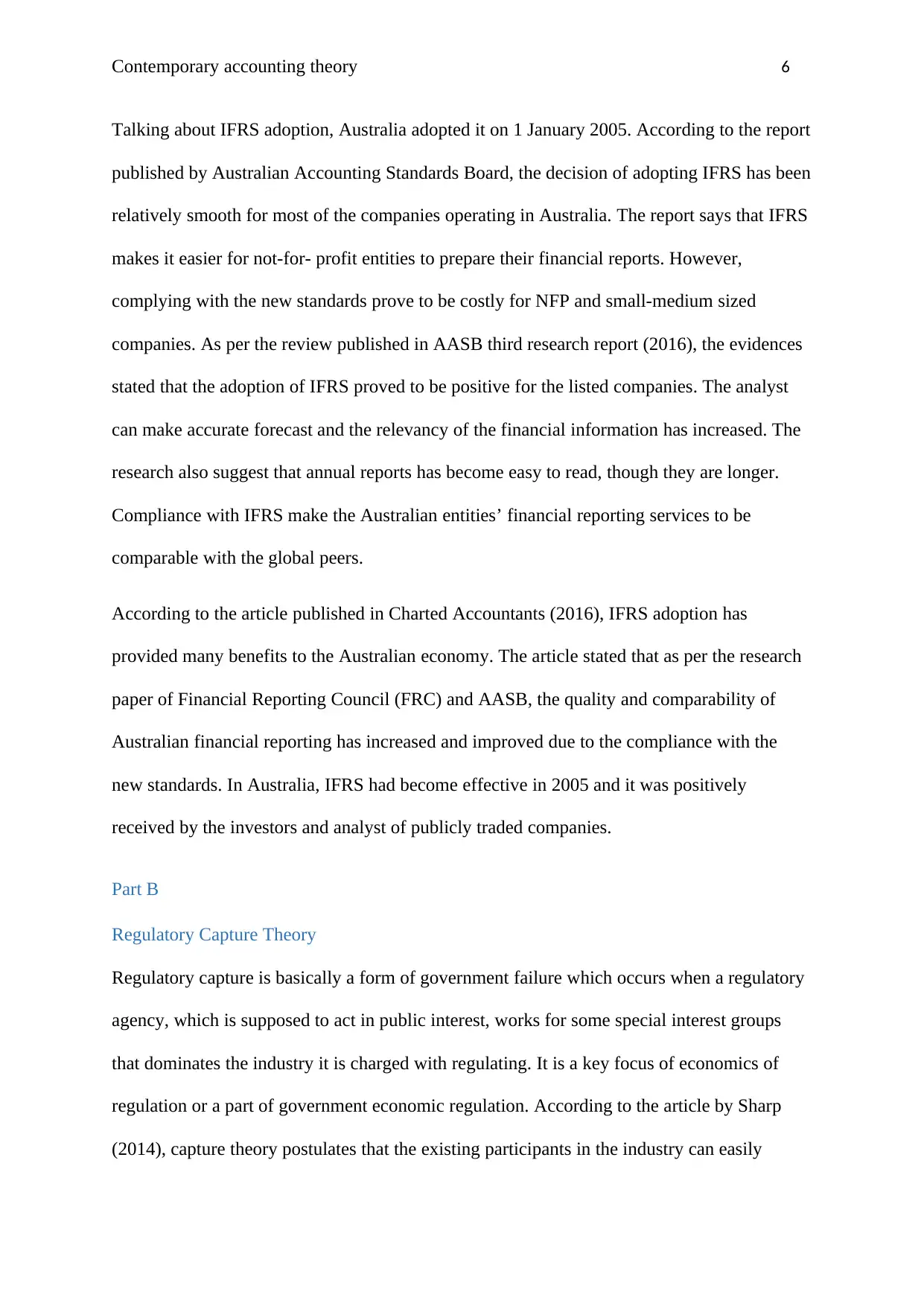
Contemporary accounting theory 6
Talking about IFRS adoption, Australia adopted it on 1 January 2005. According to the report
published by Australian Accounting Standards Board, the decision of adopting IFRS has been
relatively smooth for most of the companies operating in Australia. The report says that IFRS
makes it easier for not-for- profit entities to prepare their financial reports. However,
complying with the new standards prove to be costly for NFP and small-medium sized
companies. As per the review published in AASB third research report (2016), the evidences
stated that the adoption of IFRS proved to be positive for the listed companies. The analyst
can make accurate forecast and the relevancy of the financial information has increased. The
research also suggest that annual reports has become easy to read, though they are longer.
Compliance with IFRS make the Australian entities’ financial reporting services to be
comparable with the global peers.
According to the article published in Charted Accountants (2016), IFRS adoption has
provided many benefits to the Australian economy. The article stated that as per the research
paper of Financial Reporting Council (FRC) and AASB, the quality and comparability of
Australian financial reporting has increased and improved due to the compliance with the
new standards. In Australia, IFRS had become effective in 2005 and it was positively
received by the investors and analyst of publicly traded companies.
Part B
Regulatory Capture Theory
Regulatory capture is basically a form of government failure which occurs when a regulatory
agency, which is supposed to act in public interest, works for some special interest groups
that dominates the industry it is charged with regulating. It is a key focus of economics of
regulation or a part of government economic regulation. According to the article by Sharp
(2014), capture theory postulates that the existing participants in the industry can easily
Talking about IFRS adoption, Australia adopted it on 1 January 2005. According to the report
published by Australian Accounting Standards Board, the decision of adopting IFRS has been
relatively smooth for most of the companies operating in Australia. The report says that IFRS
makes it easier for not-for- profit entities to prepare their financial reports. However,
complying with the new standards prove to be costly for NFP and small-medium sized
companies. As per the review published in AASB third research report (2016), the evidences
stated that the adoption of IFRS proved to be positive for the listed companies. The analyst
can make accurate forecast and the relevancy of the financial information has increased. The
research also suggest that annual reports has become easy to read, though they are longer.
Compliance with IFRS make the Australian entities’ financial reporting services to be
comparable with the global peers.
According to the article published in Charted Accountants (2016), IFRS adoption has
provided many benefits to the Australian economy. The article stated that as per the research
paper of Financial Reporting Council (FRC) and AASB, the quality and comparability of
Australian financial reporting has increased and improved due to the compliance with the
new standards. In Australia, IFRS had become effective in 2005 and it was positively
received by the investors and analyst of publicly traded companies.
Part B
Regulatory Capture Theory
Regulatory capture is basically a form of government failure which occurs when a regulatory
agency, which is supposed to act in public interest, works for some special interest groups
that dominates the industry it is charged with regulating. It is a key focus of economics of
regulation or a part of government economic regulation. According to the article by Sharp
(2014), capture theory postulates that the existing participants in the industry can easily
Paraphrase This Document
Need a fresh take? Get an instant paraphrase of this document with our AI Paraphraser
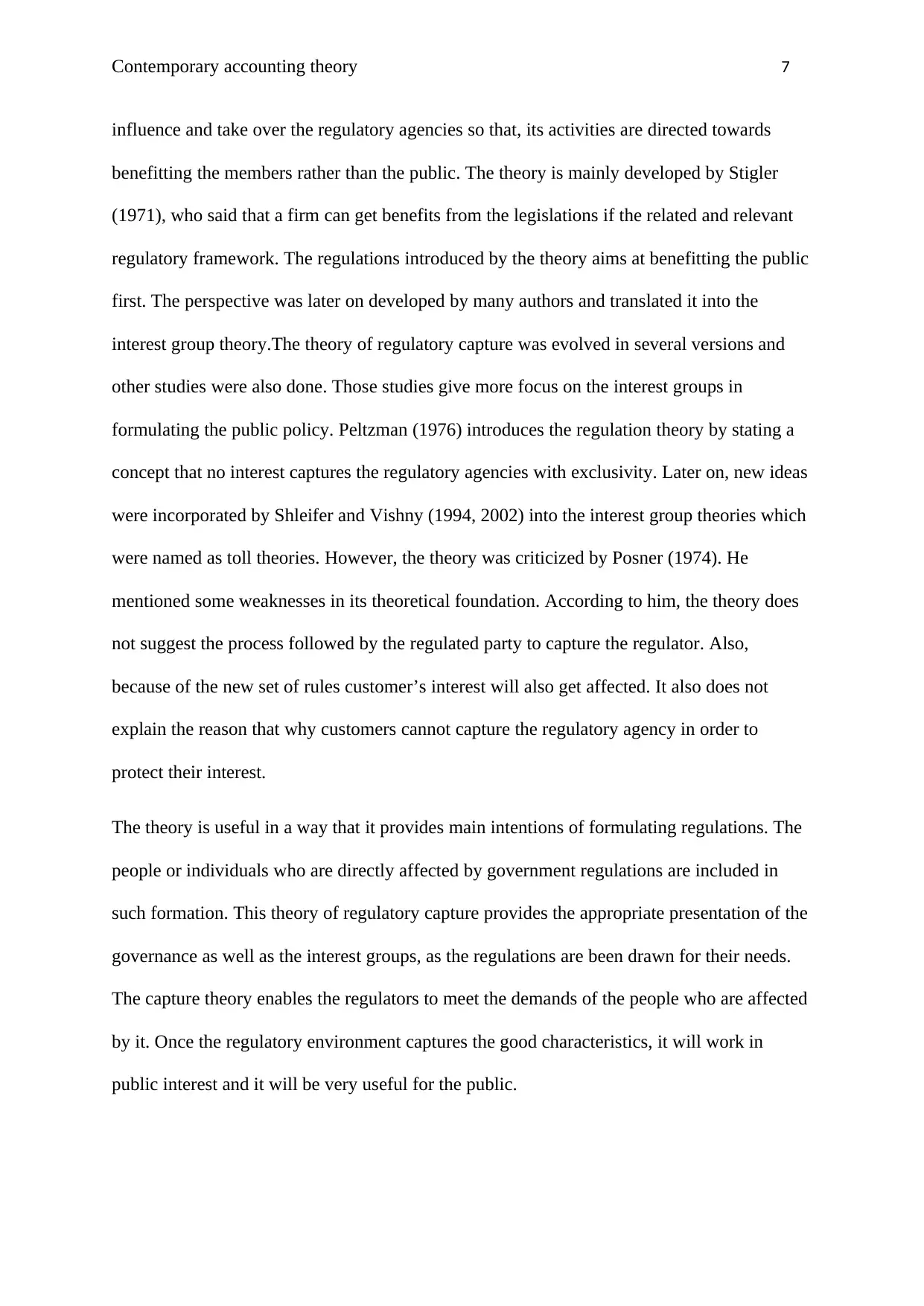
Contemporary accounting theory 7
influence and take over the regulatory agencies so that, its activities are directed towards
benefitting the members rather than the public. The theory is mainly developed by Stigler
(1971), who said that a firm can get benefits from the legislations if the related and relevant
regulatory framework. The regulations introduced by the theory aims at benefitting the public
first. The perspective was later on developed by many authors and translated it into the
interest group theory.The theory of regulatory capture was evolved in several versions and
other studies were also done. Those studies give more focus on the interest groups in
formulating the public policy. Peltzman (1976) introduces the regulation theory by stating a
concept that no interest captures the regulatory agencies with exclusivity. Later on, new ideas
were incorporated by Shleifer and Vishny (1994, 2002) into the interest group theories which
were named as toll theories. However, the theory was criticized by Posner (1974). He
mentioned some weaknesses in its theoretical foundation. According to him, the theory does
not suggest the process followed by the regulated party to capture the regulator. Also,
because of the new set of rules customer’s interest will also get affected. It also does not
explain the reason that why customers cannot capture the regulatory agency in order to
protect their interest.
The theory is useful in a way that it provides main intentions of formulating regulations. The
people or individuals who are directly affected by government regulations are included in
such formation. This theory of regulatory capture provides the appropriate presentation of the
governance as well as the interest groups, as the regulations are been drawn for their needs.
The capture theory enables the regulators to meet the demands of the people who are affected
by it. Once the regulatory environment captures the good characteristics, it will work in
public interest and it will be very useful for the public.
influence and take over the regulatory agencies so that, its activities are directed towards
benefitting the members rather than the public. The theory is mainly developed by Stigler
(1971), who said that a firm can get benefits from the legislations if the related and relevant
regulatory framework. The regulations introduced by the theory aims at benefitting the public
first. The perspective was later on developed by many authors and translated it into the
interest group theory.The theory of regulatory capture was evolved in several versions and
other studies were also done. Those studies give more focus on the interest groups in
formulating the public policy. Peltzman (1976) introduces the regulation theory by stating a
concept that no interest captures the regulatory agencies with exclusivity. Later on, new ideas
were incorporated by Shleifer and Vishny (1994, 2002) into the interest group theories which
were named as toll theories. However, the theory was criticized by Posner (1974). He
mentioned some weaknesses in its theoretical foundation. According to him, the theory does
not suggest the process followed by the regulated party to capture the regulator. Also,
because of the new set of rules customer’s interest will also get affected. It also does not
explain the reason that why customers cannot capture the regulatory agency in order to
protect their interest.
The theory is useful in a way that it provides main intentions of formulating regulations. The
people or individuals who are directly affected by government regulations are included in
such formation. This theory of regulatory capture provides the appropriate presentation of the
governance as well as the interest groups, as the regulations are been drawn for their needs.
The capture theory enables the regulators to meet the demands of the people who are affected
by it. Once the regulatory environment captures the good characteristics, it will work in
public interest and it will be very useful for the public.
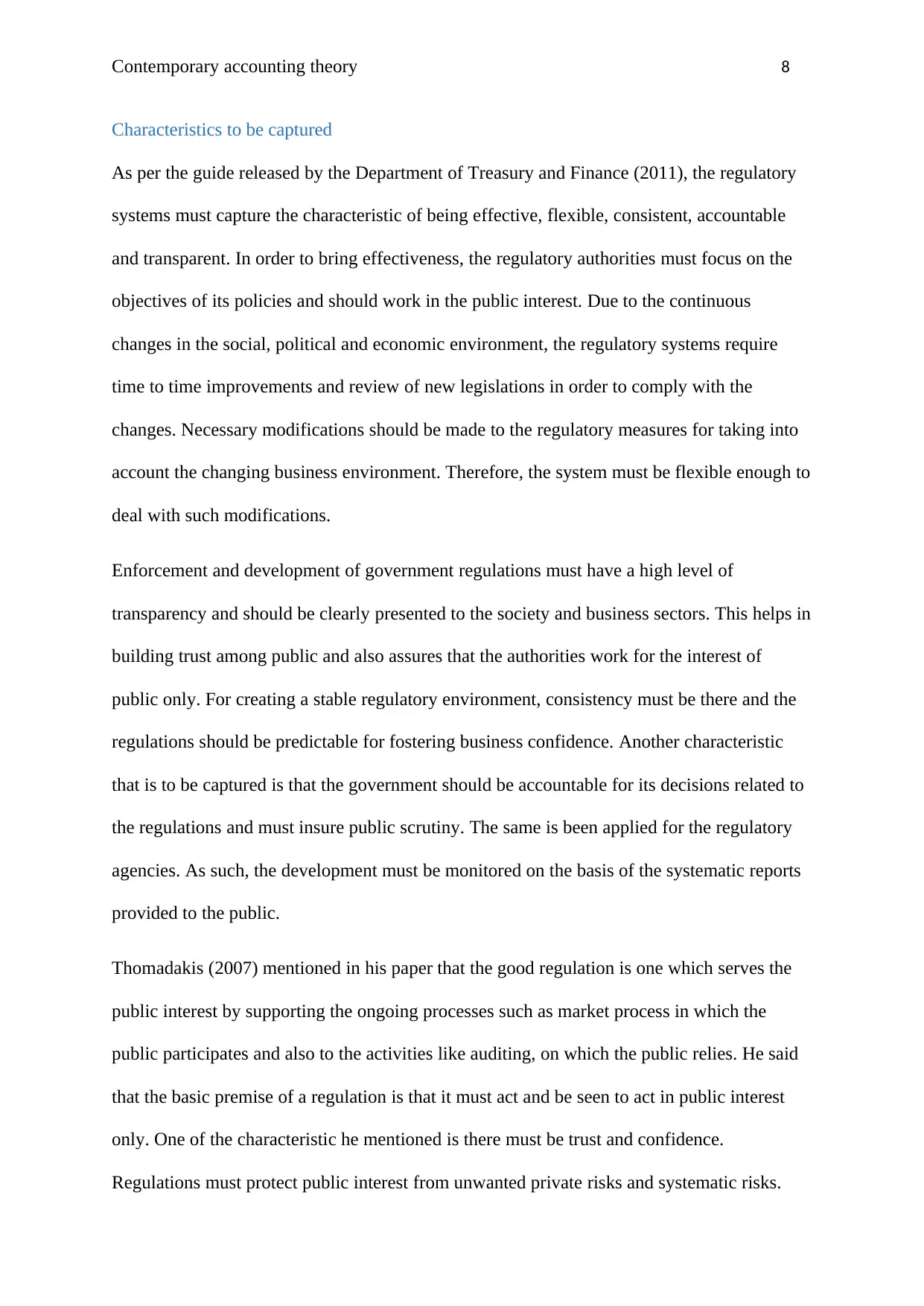
Contemporary accounting theory 8
Characteristics to be captured
As per the guide released by the Department of Treasury and Finance (2011), the regulatory
systems must capture the characteristic of being effective, flexible, consistent, accountable
and transparent. In order to bring effectiveness, the regulatory authorities must focus on the
objectives of its policies and should work in the public interest. Due to the continuous
changes in the social, political and economic environment, the regulatory systems require
time to time improvements and review of new legislations in order to comply with the
changes. Necessary modifications should be made to the regulatory measures for taking into
account the changing business environment. Therefore, the system must be flexible enough to
deal with such modifications.
Enforcement and development of government regulations must have a high level of
transparency and should be clearly presented to the society and business sectors. This helps in
building trust among public and also assures that the authorities work for the interest of
public only. For creating a stable regulatory environment, consistency must be there and the
regulations should be predictable for fostering business confidence. Another characteristic
that is to be captured is that the government should be accountable for its decisions related to
the regulations and must insure public scrutiny. The same is been applied for the regulatory
agencies. As such, the development must be monitored on the basis of the systematic reports
provided to the public.
Thomadakis (2007) mentioned in his paper that the good regulation is one which serves the
public interest by supporting the ongoing processes such as market process in which the
public participates and also to the activities like auditing, on which the public relies. He said
that the basic premise of a regulation is that it must act and be seen to act in public interest
only. One of the characteristic he mentioned is there must be trust and confidence.
Regulations must protect public interest from unwanted private risks and systematic risks.
Characteristics to be captured
As per the guide released by the Department of Treasury and Finance (2011), the regulatory
systems must capture the characteristic of being effective, flexible, consistent, accountable
and transparent. In order to bring effectiveness, the regulatory authorities must focus on the
objectives of its policies and should work in the public interest. Due to the continuous
changes in the social, political and economic environment, the regulatory systems require
time to time improvements and review of new legislations in order to comply with the
changes. Necessary modifications should be made to the regulatory measures for taking into
account the changing business environment. Therefore, the system must be flexible enough to
deal with such modifications.
Enforcement and development of government regulations must have a high level of
transparency and should be clearly presented to the society and business sectors. This helps in
building trust among public and also assures that the authorities work for the interest of
public only. For creating a stable regulatory environment, consistency must be there and the
regulations should be predictable for fostering business confidence. Another characteristic
that is to be captured is that the government should be accountable for its decisions related to
the regulations and must insure public scrutiny. The same is been applied for the regulatory
agencies. As such, the development must be monitored on the basis of the systematic reports
provided to the public.
Thomadakis (2007) mentioned in his paper that the good regulation is one which serves the
public interest by supporting the ongoing processes such as market process in which the
public participates and also to the activities like auditing, on which the public relies. He said
that the basic premise of a regulation is that it must act and be seen to act in public interest
only. One of the characteristic he mentioned is there must be trust and confidence.
Regulations must protect public interest from unwanted private risks and systematic risks.
⊘ This is a preview!⊘
Do you want full access?
Subscribe today to unlock all pages.

Trusted by 1+ million students worldwide
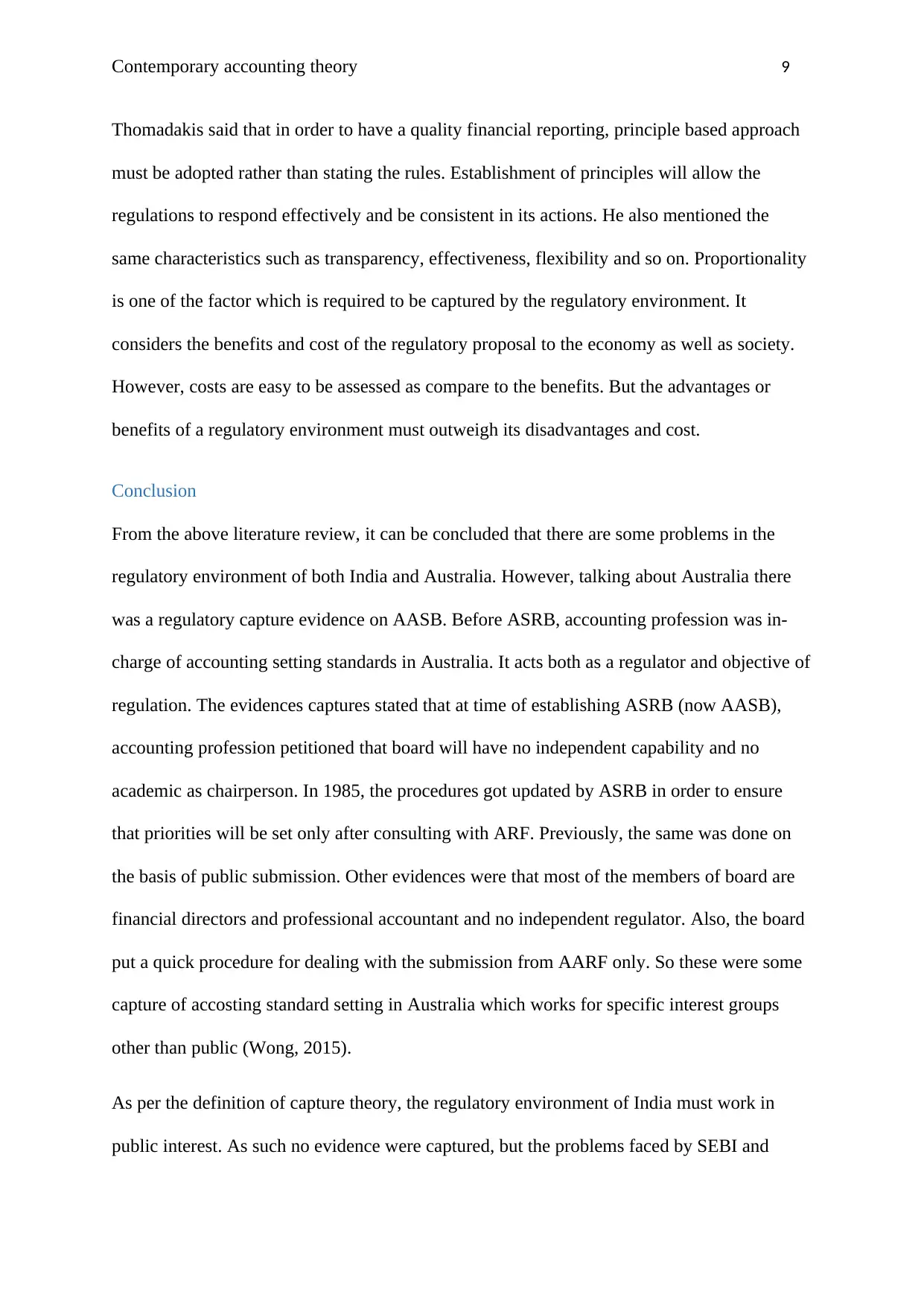
Contemporary accounting theory 9
Thomadakis said that in order to have a quality financial reporting, principle based approach
must be adopted rather than stating the rules. Establishment of principles will allow the
regulations to respond effectively and be consistent in its actions. He also mentioned the
same characteristics such as transparency, effectiveness, flexibility and so on. Proportionality
is one of the factor which is required to be captured by the regulatory environment. It
considers the benefits and cost of the regulatory proposal to the economy as well as society.
However, costs are easy to be assessed as compare to the benefits. But the advantages or
benefits of a regulatory environment must outweigh its disadvantages and cost.
Conclusion
From the above literature review, it can be concluded that there are some problems in the
regulatory environment of both India and Australia. However, talking about Australia there
was a regulatory capture evidence on AASB. Before ASRB, accounting profession was in-
charge of accounting setting standards in Australia. It acts both as a regulator and objective of
regulation. The evidences captures stated that at time of establishing ASRB (now AASB),
accounting profession petitioned that board will have no independent capability and no
academic as chairperson. In 1985, the procedures got updated by ASRB in order to ensure
that priorities will be set only after consulting with ARF. Previously, the same was done on
the basis of public submission. Other evidences were that most of the members of board are
financial directors and professional accountant and no independent regulator. Also, the board
put a quick procedure for dealing with the submission from AARF only. So these were some
capture of accosting standard setting in Australia which works for specific interest groups
other than public (Wong, 2015).
As per the definition of capture theory, the regulatory environment of India must work in
public interest. As such no evidence were captured, but the problems faced by SEBI and
Thomadakis said that in order to have a quality financial reporting, principle based approach
must be adopted rather than stating the rules. Establishment of principles will allow the
regulations to respond effectively and be consistent in its actions. He also mentioned the
same characteristics such as transparency, effectiveness, flexibility and so on. Proportionality
is one of the factor which is required to be captured by the regulatory environment. It
considers the benefits and cost of the regulatory proposal to the economy as well as society.
However, costs are easy to be assessed as compare to the benefits. But the advantages or
benefits of a regulatory environment must outweigh its disadvantages and cost.
Conclusion
From the above literature review, it can be concluded that there are some problems in the
regulatory environment of both India and Australia. However, talking about Australia there
was a regulatory capture evidence on AASB. Before ASRB, accounting profession was in-
charge of accounting setting standards in Australia. It acts both as a regulator and objective of
regulation. The evidences captures stated that at time of establishing ASRB (now AASB),
accounting profession petitioned that board will have no independent capability and no
academic as chairperson. In 1985, the procedures got updated by ASRB in order to ensure
that priorities will be set only after consulting with ARF. Previously, the same was done on
the basis of public submission. Other evidences were that most of the members of board are
financial directors and professional accountant and no independent regulator. Also, the board
put a quick procedure for dealing with the submission from AARF only. So these were some
capture of accosting standard setting in Australia which works for specific interest groups
other than public (Wong, 2015).
As per the definition of capture theory, the regulatory environment of India must work in
public interest. As such no evidence were captured, but the problems faced by SEBI and
Paraphrase This Document
Need a fresh take? Get an instant paraphrase of this document with our AI Paraphraser
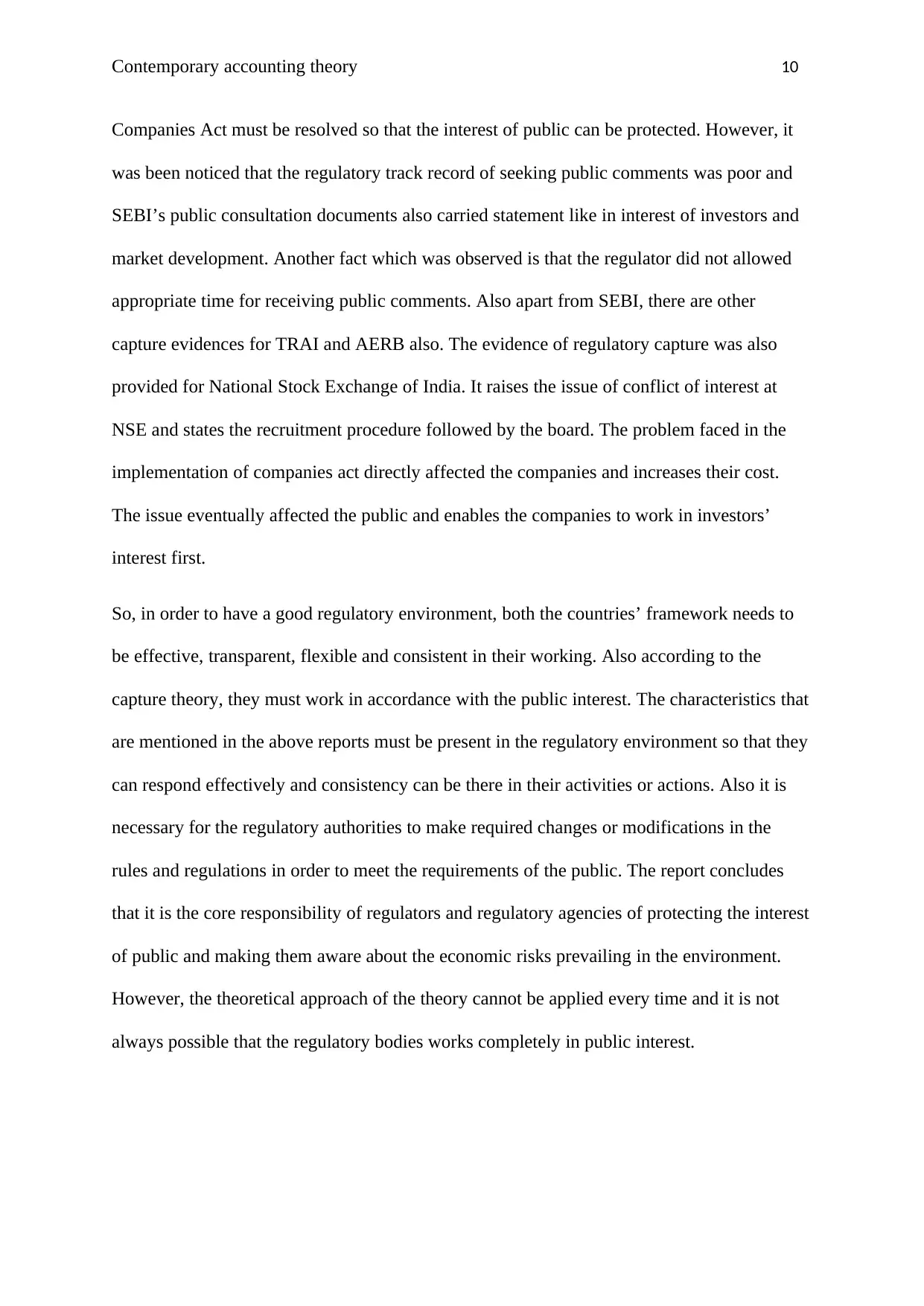
Contemporary accounting theory 10
Companies Act must be resolved so that the interest of public can be protected. However, it
was been noticed that the regulatory track record of seeking public comments was poor and
SEBI’s public consultation documents also carried statement like in interest of investors and
market development. Another fact which was observed is that the regulator did not allowed
appropriate time for receiving public comments. Also apart from SEBI, there are other
capture evidences for TRAI and AERB also. The evidence of regulatory capture was also
provided for National Stock Exchange of India. It raises the issue of conflict of interest at
NSE and states the recruitment procedure followed by the board. The problem faced in the
implementation of companies act directly affected the companies and increases their cost.
The issue eventually affected the public and enables the companies to work in investors’
interest first.
So, in order to have a good regulatory environment, both the countries’ framework needs to
be effective, transparent, flexible and consistent in their working. Also according to the
capture theory, they must work in accordance with the public interest. The characteristics that
are mentioned in the above reports must be present in the regulatory environment so that they
can respond effectively and consistency can be there in their activities or actions. Also it is
necessary for the regulatory authorities to make required changes or modifications in the
rules and regulations in order to meet the requirements of the public. The report concludes
that it is the core responsibility of regulators and regulatory agencies of protecting the interest
of public and making them aware about the economic risks prevailing in the environment.
However, the theoretical approach of the theory cannot be applied every time and it is not
always possible that the regulatory bodies works completely in public interest.
Companies Act must be resolved so that the interest of public can be protected. However, it
was been noticed that the regulatory track record of seeking public comments was poor and
SEBI’s public consultation documents also carried statement like in interest of investors and
market development. Another fact which was observed is that the regulator did not allowed
appropriate time for receiving public comments. Also apart from SEBI, there are other
capture evidences for TRAI and AERB also. The evidence of regulatory capture was also
provided for National Stock Exchange of India. It raises the issue of conflict of interest at
NSE and states the recruitment procedure followed by the board. The problem faced in the
implementation of companies act directly affected the companies and increases their cost.
The issue eventually affected the public and enables the companies to work in investors’
interest first.
So, in order to have a good regulatory environment, both the countries’ framework needs to
be effective, transparent, flexible and consistent in their working. Also according to the
capture theory, they must work in accordance with the public interest. The characteristics that
are mentioned in the above reports must be present in the regulatory environment so that they
can respond effectively and consistency can be there in their activities or actions. Also it is
necessary for the regulatory authorities to make required changes or modifications in the
rules and regulations in order to meet the requirements of the public. The report concludes
that it is the core responsibility of regulators and regulatory agencies of protecting the interest
of public and making them aware about the economic risks prevailing in the environment.
However, the theoretical approach of the theory cannot be applied every time and it is not
always possible that the regulatory bodies works completely in public interest.
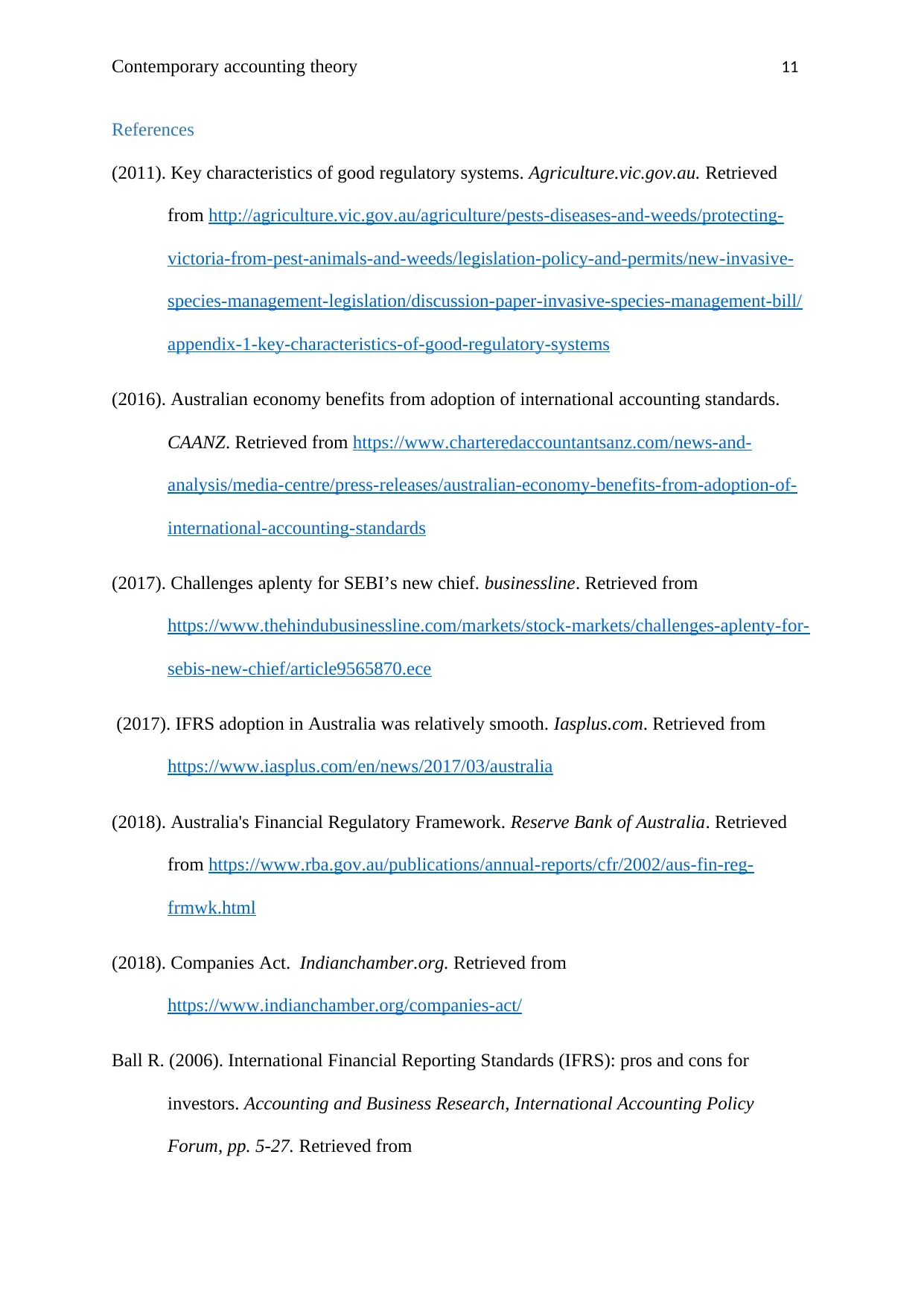
Contemporary accounting theory 11
References
(2011). Key characteristics of good regulatory systems. Agriculture.vic.gov.au. Retrieved
from http://agriculture.vic.gov.au/agriculture/pests-diseases-and-weeds/protecting-
victoria-from-pest-animals-and-weeds/legislation-policy-and-permits/new-invasive-
species-management-legislation/discussion-paper-invasive-species-management-bill/
appendix-1-key-characteristics-of-good-regulatory-systems
(2016). Australian economy benefits from adoption of international accounting standards.
CAANZ. Retrieved from https://www.charteredaccountantsanz.com/news-and-
analysis/media-centre/press-releases/australian-economy-benefits-from-adoption-of-
international-accounting-standards
(2017). Challenges aplenty for SEBI’s new chief. businessline. Retrieved from
https://www.thehindubusinessline.com/markets/stock-markets/challenges-aplenty-for-
sebis-new-chief/article9565870.ece
(2017). IFRS adoption in Australia was relatively smooth. Iasplus.com. Retrieved from
https://www.iasplus.com/en/news/2017/03/australia
(2018). Australia's Financial Regulatory Framework. Reserve Bank of Australia. Retrieved
from https://www.rba.gov.au/publications/annual-reports/cfr/2002/aus-fin-reg-
frmwk.html
(2018). Companies Act. Indianchamber.org. Retrieved from
https://www.indianchamber.org/companies-act/
Ball R. (2006). International Financial Reporting Standards (IFRS): pros and cons for
investors. Accounting and Business Research, International Accounting Policy
Forum, pp. 5-27. Retrieved from
References
(2011). Key characteristics of good regulatory systems. Agriculture.vic.gov.au. Retrieved
from http://agriculture.vic.gov.au/agriculture/pests-diseases-and-weeds/protecting-
victoria-from-pest-animals-and-weeds/legislation-policy-and-permits/new-invasive-
species-management-legislation/discussion-paper-invasive-species-management-bill/
appendix-1-key-characteristics-of-good-regulatory-systems
(2016). Australian economy benefits from adoption of international accounting standards.
CAANZ. Retrieved from https://www.charteredaccountantsanz.com/news-and-
analysis/media-centre/press-releases/australian-economy-benefits-from-adoption-of-
international-accounting-standards
(2017). Challenges aplenty for SEBI’s new chief. businessline. Retrieved from
https://www.thehindubusinessline.com/markets/stock-markets/challenges-aplenty-for-
sebis-new-chief/article9565870.ece
(2017). IFRS adoption in Australia was relatively smooth. Iasplus.com. Retrieved from
https://www.iasplus.com/en/news/2017/03/australia
(2018). Australia's Financial Regulatory Framework. Reserve Bank of Australia. Retrieved
from https://www.rba.gov.au/publications/annual-reports/cfr/2002/aus-fin-reg-
frmwk.html
(2018). Companies Act. Indianchamber.org. Retrieved from
https://www.indianchamber.org/companies-act/
Ball R. (2006). International Financial Reporting Standards (IFRS): pros and cons for
investors. Accounting and Business Research, International Accounting Policy
Forum, pp. 5-27. Retrieved from
⊘ This is a preview!⊘
Do you want full access?
Subscribe today to unlock all pages.

Trusted by 1+ million students worldwide
1 out of 14
Related Documents
Your All-in-One AI-Powered Toolkit for Academic Success.
+13062052269
info@desklib.com
Available 24*7 on WhatsApp / Email
![[object Object]](/_next/static/media/star-bottom.7253800d.svg)
Unlock your academic potential
Copyright © 2020–2025 A2Z Services. All Rights Reserved. Developed and managed by ZUCOL.



